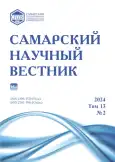Образ Неоптолема в генеалогии молосских Эакидов
- Авторы: Казаров С.С.1
-
Учреждения:
- Южный федеральный университет
- Выпуск: Том 13, № 2 (2024)
- Страницы: 107-110
- Раздел: Исторические науки
- URL: https://journal-vniispk.ru/2309-4370/article/view/271347
- DOI: https://doi.org/10.55355/snv2024132203
- ID: 271347
Цитировать
Полный текст
Аннотация
Некоторые районы Древней Эллады, находившиеся на границе варварского и греческого миров и отставая в политическом и культурном отношении от центра, тем или иным путем стремились доказать свое «греческое» происхождение. Особенно этого относилось к царским династиям, которые, выводя свою генеалогию из мифологических героев, тем самым обосновывали свои претензии на эллинское происхождение. Подобным примером может послужить правящая в Эпире молосская династия Эакидов, которая выводила свое происхождение от мифологического героя Неоптолема, сына Ахилла. Происходило это в тот момент, когда Эпир и правящая династия вышли из исторической тени и стали активнее участвовать в общегреческих делах. В качестве главного источника для этого послужили сюжеты из Троянской войны, повествующие о возвращении героев после разгрома Трои. Зачастую представители царской династии при рождении получали имена мифологических героев, что должно было служить подтверждением их высокого происхождения. Со временем генеалогия молосских царей дополнялась и расширялась путем введения в нее новых мифологических персонажей. В правление царя Пирра в героическую генеалогию молосских царей была внесена его супруга Ланасса. Имя Неоптолема носили и два реальных персонажа эпирской истории, судьбы которых не были счастливыми.
Ключевые слова
Полный текст
Открыть статью на сайте журналаОб авторах
Саркис Суренович Казаров
Южный федеральный университет
Автор, ответственный за переписку.
Email: ser-kazarov@yandex.ru
доктор исторических наук, профессор кафедры археологии и истории Древнего мира
Россия, Ростов-на-ДонуСписок литературы
- Malkin I. The Returns of Odysseus. Berkley: University of California Press, 1998. 331 p.
- Kittela S.-I. Dodona and Neoptolemus: Heroic Genealogies and Claims of Ethnicity // Studies of Ancient Oracles and Divination / ed. by M. Kajava. Roma, 2013. P. 29–47.
- Robertson D.S. Euripides and Tharyps // The Classical Review. 1923. Vol. 37, iss. 3–4. P. 58–60. doi: 10.1017/s0009840x00041536.
- Hammond N.G.L. Epirus. Oxford: Clarendon Press, 1967. 847 p.
- Cross G.N. Epirus: a Study in Greek Constitutional Development. Cambridge: Cambridge University Press, 1932. 137 p. doi: 10.1017/s0017383500002102.
- Sandberger F. Prosopographie zur Geschichte des Pyrrhos. Munchen: Inaugural-Dissertation, 1970. 216 s.
- Cabouret B. La religion des Grecs // De Zeus a Allah. Les Grandes Religions du Monde Mediterraneen. Nantes: Du Temps, 2004. P. 13–52.
- Nilsson M.P. Studien zur Geschichte des alten Epeiros. Lund: Lunds Universitets Arksskrift, 1909. 77 s.
- Schubert R. Geschichte des Pyrrhus. Konigsberg: Verlag von W. Koch, 1894. 288 s.
- Fragmenta historicorum Graecorum / ed. C. Muller. Bd. III. Paris: Ambrosio Firmin Didot, 1849. 729 p.
- Hüttner U. Die politische Rolle des Heraklesgestalt in Griechischen Herrschertums. Stuttgart: F. Steiner, 1997. 385 s.
- Franke P.R. Alt-Epirus und das Konigtum der Molosser. Kallmunz: Michael Lassleben, 1955. 89 s.
- Казаров С.С. Пирр, царь Эпира. М.: Проспект, 2023. 272 с.
Дополнительные файлы






